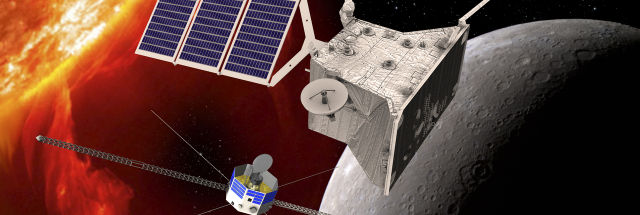An artist’s rendering of the BepiColombo mission, a joint ESA/JAXA project, which will take two spacecraft to the harsh environment of Mercury.
ESA
This week, the European Space Agency posted a somewhat ominous note about its BepiColombo spacecraft, which consists of two orbiters headed to Mercury.
The online press release mentioned a “glitch” with the spacecraft that is harming its ability to generate thrust. The problem was first noticed on April 26, when the spacecraft’s primary propulsion system was scheduled to perform an orbital maneuver. Sufficient electrical power was not supplied to the solar electric propulsion system at that time.
According to the space agency, a team of its own engineers and those of its industrial partners began working on the issue. By May 7, they had made some progress, restoring the spacecraft’s thrust to about 90 percent of its original level. But this is not the full scope, and the root of the problem remains poorly understood.
This is an ambitious mission, with an estimated cost of $2 billion. In collaboration with the Japanese space agency JAXA, BepiColombo was launched in October 2018 on an Ariane 5 rocket. So there’s a lot riding on these thrusters. The crucial question is: At this power level, can BepiColombo still fulfill its primary task: reaching orbit around Mercury?
The answer to this question is not so clear.
A three-piece spacecraft
The spacecraft consists of three components. The “transfer module” is where the current problems arise. It was built by the European Space Agency and is intended to power the other two components of the spacecraft until October 2025. It is essential for positioning the spacecraft before entering orbit around Mercury. The other two elements of the mission are a European orbiter, MPO, and a Japanese orbiter, Mio. After their planned arrival in orbit around Mercury in December 2025, the two orbiters will separate and conduct at least a year’s worth of observations, including the characterization of the small planet’s magnetic field.
The press release is ambiguous about the fate of BepiColombo if the propulsion system cannot be restored to full power.
Ars contacted the European Space Agency and asked whether BepiColombo can still reach orbit around Mercury in this state. The answer, a statement from Elsa Montagnon, the space agency’s chief of mission operations, is not entirely clear.
“Thank you for your legitimate questions about the current uncertainty,” Montagnon said. “We are working hard to resolve these uncertainties.”
I need that delta-V
What is clear, she said, is that the current level of momentum can support the next critical milestone, BepiColombo’s fourth Mercury swing, which will occur on September 5 this year. This is the first of three swing-bys that will occur in quick succession from September to January and will slow the spacecraft relative to Mercury.
“This swing-by sequence creates a braking delta-V of 2.4 km/s and causes a change in the velocity vector direction relative to the Sun, as required for the trajectory endgame in 2025,” Montagnon said .
Currently, a team of experts is working on the implications of reduced thrusters for the other two parts of this swing-by sequence and other propulsion needs in 2025.
This transfer module is planned to be removed from the rest of the stack in October 2025, and then the remaining Mercury approach and orbit insertion maneuvers will be performed using the chemical propulsion subsystem of the European MPO spacecraft.
